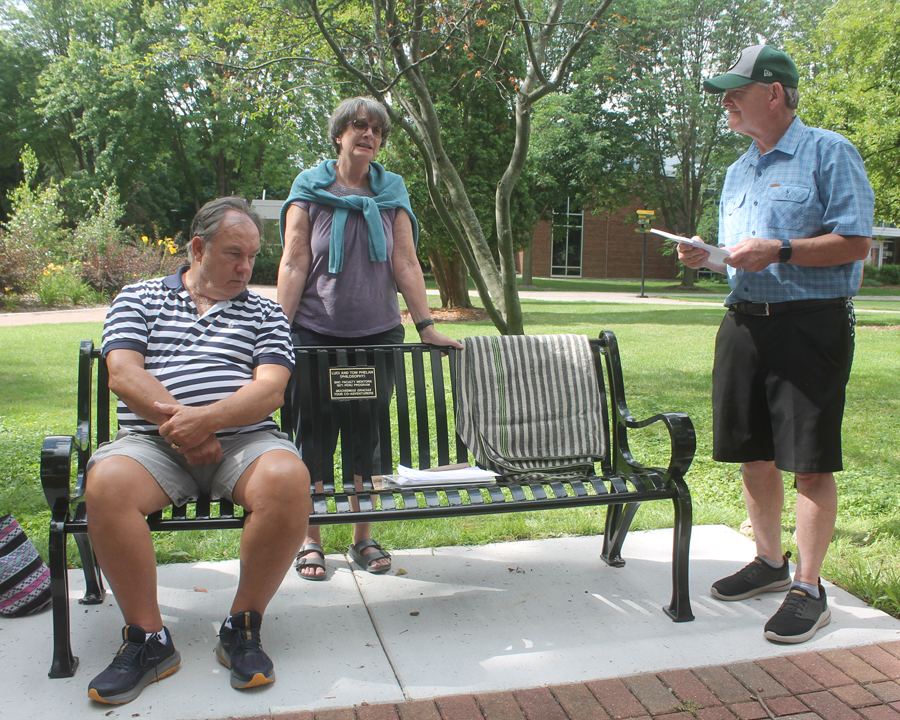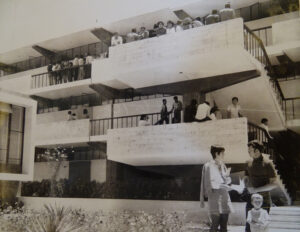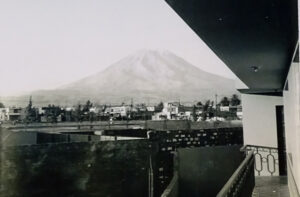
By Kris Leonhardt
Editor-in-chief
DE PERE – Former participants of a 1970s visionary study-abroad program gathered Aug. 9-11 to celebrate the individuals who made it possible.
In a time when study-abroad programs were uncommon, the St. Norbert College program led the way for dozens of existing programs today and passage into an area needing assistance.
It all began with a Christmas-time conversation between St. Norbert College professor, Frank Wood and Sister Marie Esterre, where the sister expressed the need for English teachers in the growing community of Arequipa, Peru.
Sister Marie Esterre was Wood’s sister-in-law and had recently been named Mother Superior of the St. Joseph of Carondelet in Arequipa.
From there, a plan for a nine-month program “living-teaching-learning,” as coined by the Sheboygan Press, was born in conjunction with the Catholic University of Santa Maria.
Organized by the college’s experimental studies program and foreign language department, as the first Hispanic study abroad program under the direction of Wood and Daniel Ritter, the program would provide students with the opportunity to experience a new culture while conducting classes in English.
On March 23, 1970, Wood, his wife Agnes and children — Mary, Patrick, Dan, Chris, Mike, Becca, Tom and Megan — left for Peru, joined by seven St. Norbert students.
To prepare, students took crash courses in Spanish, South American culture and Peruvian history.
Each student was then housed with a Peruvian family in Arequipa, which is located about 18 hours by bus from Lima, Peru, and was said to have a population about the size of St. Paul, Minn., at the time.
There, the students also took Spanish language courses, while an archeology class was also offered by a local Marianist monk.
In 1971, the program once again headed to Arequipa, led by Tom and Luci Phelan and their four sons — Sean, Brian, Terry and Patrick.
With this trip, the number of students doubled in size, with 15 making the trip.
During semester break in July, students took trips to Chile, the jungles of Vilcabamba and the Inca ruins at Cuzco and Machi Picchu, while some headed to see the earthquake-ravaged area by Chimbote.
One year earlier, in May 1970, an earthquake that originated off the coast of Peru caused massive landslides and left an estimated 70,000 people homeless, with 37,000 dead.
While the group was in Peru, the airlines they were using — Peru National Airline — went bankrupt and wasn’t issuing refunds.
Stranded — Green Bay Press Gazette announced their return on Jan. 8.
“The college student newspaper had articles at that time that indicated that we were “stranded” there. I’m sure that we never felt either trapped or stranded. We had an opportunity in June or July to be flown home by another South American airline, but none of us, especially Tom and Luci, wanted to leave. I guess we simply assumed that the college would figure some way to get us home again. We were having such an incredible experience that we didn’t want to cut it short,” said Barbara Bobrowitz, who was part of that group and one of the reunion organizers.

And the college did figure it out indeed.
According to a Green Bay Press Gazette article, Frank Wood contacted Sen. William Proxmire and Braniff International airlines and got approval to fly the group home at half price.
“You just can’t fly people home at half fare,” Wood said. “You have to get permission from the Civil Aeronautics Board.”
The program’s third and final year — 1972 — was led by Richard and Mechtilde Calnin and included 13 students prepared by attending three special courses — Peruvian history and culture, intense language study and advanced Spanish conversation.
“We were supposed to be teaching English at the Catholic university,” said Bob Rosek, who participated in the program that year.
“In solidarity with (the public university who went on strike), Santa Maria went on strike.
“So, we had gone to Santa Maria to get orientation to teach English there. They went on strike and there was no college.
“So we took independent study with the Calnins.
“We took the opportunity and did a lot of great traveling.”
Kathy (Rosenberg) Van Vonderen said that the only viable communication with those back home was through the postal service.
“You had no connection with your family, except by mail,” she said.
“We tried to call. I tried to call my parents once, but it was through a ham radio.”
Communication was difficult and very expensive, but that was a minor awakening.
Seeing the country from a distance
Maggie Phair told an Oshkosh Northwestern reporter upon their return, “I had never walked over people dying in the streets. I’d never seen real poverty until I went to Peru. I came back looking at everything from two points of view — my own as an American college student and that of the people who meant so much to me in Latin America.
“Now I see two sides to everything. I walked into my own bedroom when I came home and got angry because I have so many things. Things can be meaningless — sometimes a real burden.
“I’ve learned to value our freedoms in this country so much more than I ever had. Even though the universities there are tremendously political, the activists are always in danger of being ‘red-slipped’ (expelled) if they express themselves. The secret police are very, very powerful.”
Bob Rosek said that the man he was staying with in Peru was a “proud socialist.”
“I was open-minded, and I liked a lot of his ideas. I didn’t argue with him much. He told me his viewpoints,” Rosek recalled during the reunion.
“Whenever anyone was mad at the U.S. or the policies, they would tell us it’s not you.

“Seeing his view of North America through his eyes… it was interesting to see our country from a distance. It’s a good eye-opener, very educational; you see things you don’t see when you are close in.
“One of the memorable moments I had is going through the plaza and the armistice. It was just filled with people; they were burning Richard Nixon (images) in effigy, burning American flags.
That image was also vivid for Van Vonderen.
“You went there thinking that you were pretty smart and pretty good, pretty rich; and you come back and it is like, I was pretty stupid. I was very humbled by what I had seen,” she said.
“Nixon had done some things politically that had really hurt the coast of South America, had encroached on their rights.
“In those days (you didn’t disrespect the flag); you couldn’t have the flag on your pants or anything. You never disgraced the American flag at all and to see it burned was horrifying.”
The warmth of the people
But, the uneasiness of those situations was not outweighed by the kindness they were shown.
“I had wonderful parents and family, but it was a very warm environment there,” Phair recalled during the reunion.
“I really lucked out with the family. They didn’t see me as there for nine months; they saw me as like an adopted daughter.
“I missed that when I came home — kind of like a real closeness, a real family closeness.”
Craig Moyles felt that same closeness with his Peruvian family.
“With one month to go, my Peruvian brother and I wanted to go to a beach town on the other side of the Andes Mountains,” Moyles recalled. “We took a bus from the city and then started hitchhiking.”
They got a ride partway from a police officer until a split in the road where they found another accommodating driver.
“We got in this car, and we were only in the car 10-15 minutes, and we were in a head-on collision.”
Moyles was thrown from the car and spent 10 days in a coma and three weeks in the hospital.
“Peru has been a life-changing experience and I got close to the family as well,” he said.
He now has Peruvian grand-nieces and nephews, who continue to keep in touch.
Moyles said that the trip has also given him an affinity for travel.
He started traveling in 1984 and said that in the first 30 months, he took 20 trips.
“That is my claim to fame,” he said.
The dedication
With life-long friendship created, the three groups have continued to gather over the years, most recently coming together for a combined three-day affair.
The event was spearheaded by the 1971 group, who had collected funding to place a bench on the college campus as a tribute to the family who had led the trip that year.
“Our group, I believe, views the bench not so much as a gift to the college but more as a tribute to Tom and Luci Phelan. Secondarily, it will benefit the students and the college,” Bobrowitz explained.

Inspired by the idea, benches were also funded for the Wood and Calnin families.
On Aug. 12, a dedication ceremony was held for the benches near the Shakespeare Memorial Garden on the college campus, where the Phelan and Wood benches had already been placed, with the Calnin bench to be installed later.
The air of the dedication is best summed up in a blessing verse, read that morning.
May you be able to journey to that place in your soul where
there is great love, warmth, feeling and forgiveness.
May this change you.
May it transfigure that which is negative, distant or cold in you.
May you be brought in to the real passion, kinship and affinity of belonging.
-John O’Donohue
